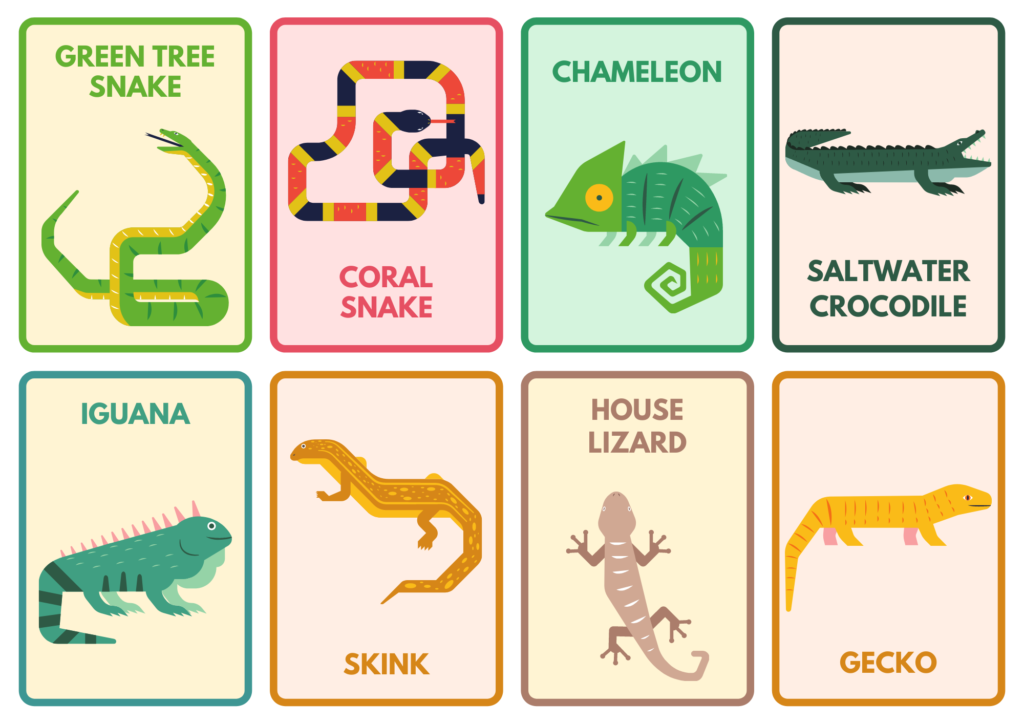
Introduction
The animal kingdom is filled with an incredible diversity of species. Each of these species has its unique characteristics and behaviors. In this article, “Animals (2), we will delve into the captivating world of green tree snakes, coral snakes, chameleons, saltwater crocodiles, iguanas, skinks, house lizards, and geckos. All of these creatures have adapted to various habitats. they have showcased the marvels of evolution and survival.
Green Tree Snakes
Green tree snakes have vibrant green coloration, slender bodies, and excellent climbing abilities. They are a sight to behold. These non-venomous constrictors live in the rainforests of Australia, New Guinea, and nearby islands. Their agile nature allows them to move swiftly through the treetops, preying on small reptiles, birds, and insects. Green tree snakes play a crucial role in maintaining the ecological balance of their habitats. This makes them an essential part of the ecosystem.
Chameleons
Chameleons have a remarkable ability to change color. This a skill they employ for communication, camouflage, and temperature regulation. These captivating reptiles are predominantly found in Madagascar, Africa, and parts of the Middle East and India. Their independently mobile eyes, and long, sticky tongues make them fascinating subjects for scientific study and a source of wonder for nature enthusiasts. Chameleons are predominantly arboreal. They use their prehensile tails and specialized feet to navigate their forested habitats with ease. Their unique features and behaviors continue to captivate the imagination of people worldwide. This makes them a beloved and iconic species in the world of reptiles.
Animals (2): Coral Snakes
With their striking red, black, and yellow bands, coral snakes are among the most visually captivating reptiles. However, their beauty comes with a warning, neurotoxic venom. Found in the Americas, these elusive snakes spend much of their time burrowing in the soil or leaf litter. Despite their venomous nature, coral snakes are reclusive and tend to avoid confrontation with humans. Understanding their behavior is vital for coexisting harmoniously with these fascinating creatures.
Animals (2): Saltwater Crocodiles
The saltwater crocodile is the largest living reptile. It inhabits the brackish and freshwater regions of Southeast Asia and Northern Australia. These apex predators are famous for their immense size, powerful jaws, and remarkable ability to thrive in both salt and freshwater environments. Revered for their prehistoric origin, saltwater crocodiles are essential to the health of their ecosystems. They regulate prey populations and shape aquatic habitats.
Animals (2): Iguanas
Iguanas are iconic reptiles that have spiny crests, impressive agility, and a herbivorous diet. They are native to Central and South America. These charismatic creatures have also established populations in Florida and other warm regions. Their ability to bask in the sun and swiftly navigate trees makes them a fascinating subject for wildlife enthusiasts. However, iguanas face threats from habitat loss and the exotic pet trade. This threat highlights the need for conservation efforts to protect these remarkable reptiles.
Animals (2): Skinks
Diverse and adaptable, skinks are a family of lizards that live across the globe, from deserts to rainforests. Their elegant bodies, smooth scales, and often vibrant colors make them a captivating group of reptiles. Skinks play essential roles in their ecosystems. They contribute to pest control and serve as prey for larger predators. The variety of skink species showcases the marvels of evolution, with each adapted to its unique environment.
House Lizards and Geckos
House lizards and geckos are universal creatures that we can find in urban and rural environments worldwide. These small reptiles have remarkable climbing abilities. They have specialized toe pads that enable them to scale vertical surfaces with ease. While some may consider them pests, these lizards contribute to pest control by feeding on insects. This makes them valuable allies in maintaining a balanced ecosystem, particularly in human-inhabited spaces.
Conclusion
The world of green tree snakes, coral snakes, saltwater crocodiles, iguanas, skinks, house lizards, and geckos is a testament to the astonishing diversity of reptiles. From the lush rainforests to urban landscapes, these creatures continue to intrigue and inspire humans. Understanding and appreciating these reptiles is essential for their conservation and the preservation of the delicate balance of nature. As we continue to explore and learn about these remarkable creatures, we have to strive to protect and coexist with them harmoniously.






